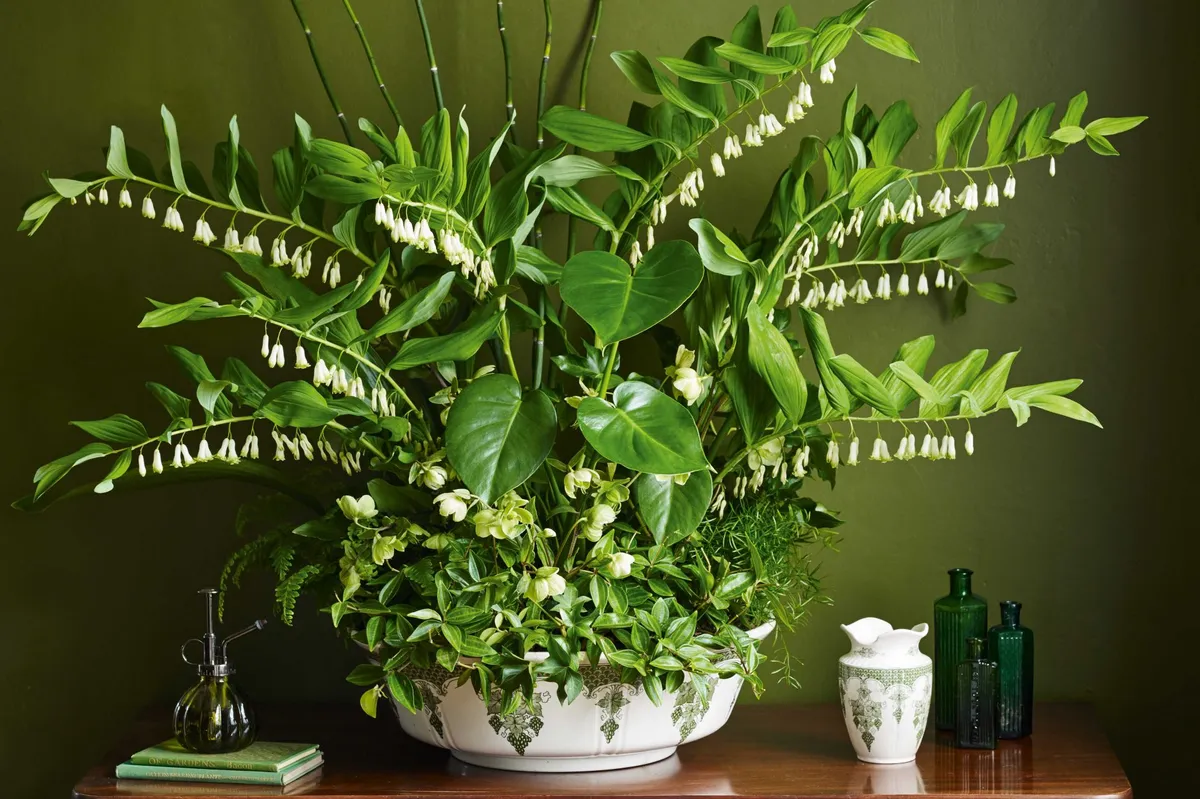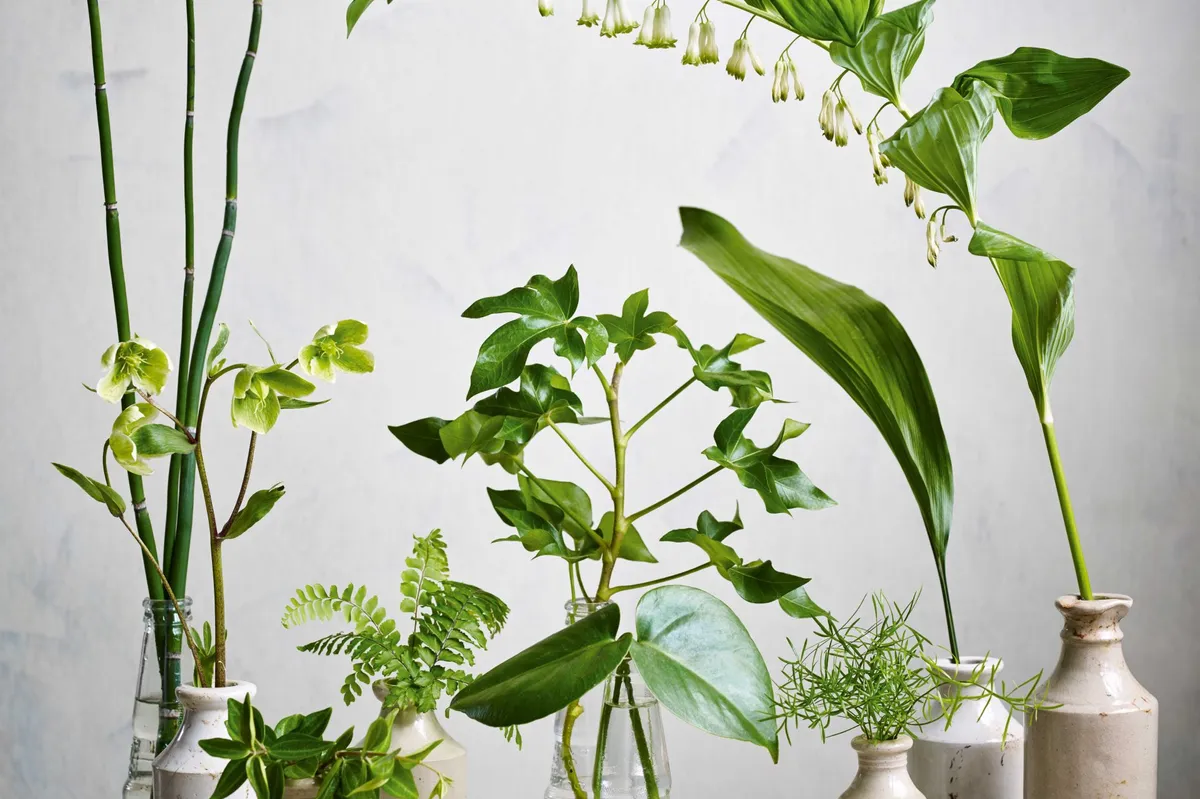The Victorians loved to show off, and table centrepieces became increasingly extravagant throughout the 19th century, often displaying a cornucopia of newly introduced houseplants teamed with exotic blooms and fruit. I wanted to capture a little of that dark and moody flamboyancy against the rich olive green of this wall. The arrangement was built around an aspidistra, the epitome of Victorian houseplants, combined with a selection of deep-green plants with similar and contrasting leaf textures.

Pot et fleur with aspidistra How to achieve the look
A glazed Victorian wash bowl, is ideal for this flamboyant display. It has no drainage holes, so won’t leak on to furniture, but will need careful watering. To begin, I lined the bowl with expanded clay pellets to absorb excess water then added a propriety houseplant compost mixed with extra charcoal. I placed the houseplants in the compost but kept the cheese plant (Monstera deliciosa) in its own pot for ease of removal, as it will quickly outgrow the display. Finally, I sank four thin-necked glass vases in the gaps, before top dressing with additional clay pellets.
The aspidistra copes well with shade, as do the other houseplants, inlcuding x Fatshedera lizei ‘Pia’, a cross between Fatsia japonica and Hedera helix. I placed two trailing peperomia at the front of the bowl to cascade over the lip. For foliar contrast I added a maidenhair and an asparagus fern.
The clean lines of the polygonatum’s tall, arching stems embellished with pendent flowers sits perfectly above the fading flowers of Helleborus x sahinii ‘Winterbells’, which take on a greener hue with age. The ridged, clean stems of Equisetum hyemale add a vertical contrast to the composition.
The arrangement needs a spot away from direct sunlight and regular misting. Overwatering is often the cause of a plant’s demise, so always check the compost before watering. If you don’t trust your finger use a water indication stick. Houseplants benefit from a weekly balanced liquid feed in the growing season, but too much nitrogen can lead to weak sappy growth.

Plants
1 Equisetum hyemale Evergreen, marginal plant. 90cm. USDA 4a-9b.
2 Helleborus x sahinii ‘Winterbells’ January to April. 30cm. USDA 4a-9b.
3 Peperomia ‘Rocca Verde’ South American trailing plant. 15cm.
4 Adiantum hispidulum ‘Bronze Venus’ Rosy maidenhair fern. 45cm.
5 x Fatshedera lizei ‘Pia’ The ivy tree. 2m. AGM*. RHS H3, USDA 7a-10b.
6 Monstera deliciosa Cheese plant. 2.5m. AGM. RHS H1B, USDA 10a-12.
7 Asparagus aethiopicus Asparagus fern. 30cm. AGM.
8 Aspidistra elatior Sometimes known as the cast iron plant. 70cm.
9 Polygonatum x hybridum A tall perennial. April to June. 90cm.
Equipment you'll need
- Traditionally, ornate punch bowls or soup tureens were used to hold elaborate, pot-et-fleur designs but any container could be adapted for a more contemporary approach including terracotta and ceramic bowls, willow baskets, glass aquariums or metal boxes, but if it’s not water tight, you’ll need to take care to protect the surface it sits on.
- Within the main container you can use any sealed vessel to hold the cut flowers but if it will be partially visible, opt for more attractive containers, such as old ink pots or vintage glass bottles that have a wide base and thin neck. Glass test tubes are a good option but take care when burying them in case they break, and always secure safely.
- A pin holder is an excellent way of accurately securing heavy stems. These discs of metal spikes are much relied on in the practice of ikebana, the Japanese art of flower arranging, lending a more naturalistic feel to an arrangement. I also use several heavy, semi-spherical glass frogs to hold flowers and branch stems. Be sure to attach both of these securely to the base of the vase with floral putty or tape before arranging. A length of wide-gauge chicken wire scrunched into a loose ball will do a similar job. Sharp scissors or secateurs are also essential bits of kit; thorn and leaf strippers are useful too.
- Before you start arranging your cut flowers, snip off the ends of picked stems and remove any foliage that will be below the water level and leave in deep water for up to 24 hours. Regularly topping up water levels or changing the water entirely every couple of days will help the arrangement last longer as air locks and bacteria will quickly cause a stem to wilt.
- Houseplants are easily killed through overwatering, so using hydroleca clay expanded pellets will not only add an attractive finish to the container, they will also absorb extra water, slowly releasing it as the compost dries out. They help maintain a humid microclimate around the plants when wet and even out fluctuations in the surrounding temperature. Activated charcoal is another useful addition to the growing medium as it reduces the build up of impurities minimising odours.
- Propriety brands of houseplant potting compost with an open, free-draining mix should be sufficient for most growing needs but you can improve drainage by adding perlite, vermiculite, horticultural sand or grit. A top dressing of decorative gravel, clay pellets or moss will also reduce water loss.
- A slim watering can with a long narrow spout for small spaces is ideal for these displays, but misting is an excellent way to maintain the humidity around plant leaves.
Read more about the art of pot et fleur